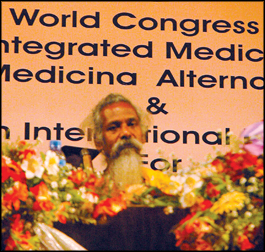Healthwatch
|
Compiled and
coordinated by Edward Arambewala |
Modern lifestyle - cause for all ills
Vedda Chief Wannila Aththo tells Int’l Medical
Congress in Colombo:
Sri Lanka’s Vedda Community Chief Uruwarige Wannila Aththo told the
World Congress of Integrated Medicines at their 46th annual conference
held at the BMICH in Colombo on Friday last week “You have invited me to
speak on our traditional system of medicines may be to see what you can
get from us to meet your medical problems most of which are rooted in
the modern lifestyle that you have adopted to live in.
 We
Veddas are living with nature in the natural environment and our medical
systems are nature based and traditional. I don’t think you can follow
us in toto; but my advice for you is to stop destroying the natural
environment in planning your development work. We
Veddas are living with nature in the natural environment and our medical
systems are nature based and traditional. I don’t think you can follow
us in toto; but my advice for you is to stop destroying the natural
environment in planning your development work.
I don’t see any benefit for human life in destroying nature gifted
trees, plants and flowers and replacing them with industry made
artificial trees, plants and flowers which you are doing now.
My advice for you is to get the people to curtail destroying the
environment in planning development as much as possible. That’s the best
for human health and health of the world as well.
He thanked Dr. Githanjana Mendis Chairman Medicine Alternative and
the Open International University for Complementary Medicine, and
Director General of Sports Medicine Ministry of Sports Sri Lanka, for
inviting him to the Congress as a special honoured guest and for getting
him to speak at the Congress. He spoke in the vedda native language and
it was translated into Sinhala and English.
God gifted wonder plant Gymnema
Chewing few fresh leaves of Gymnema per day
Glucose care herbal leaves that may block the sugar absorption. It
helps in weight and diet control, particularly for over-weight people,
sugar cravers and people who concerned about blood sugar. This plant is
called Masbedda in Sri Lanka.
 Practical
vses: Practical
vses:
The benefits of Gymnema Sylvestre are twofold:
By suppressing the taste of sweet food, the desire to eat them is
also suppressed. Picture a luscious looking large piece of chocolate
candy, which you know despite the tempting look, is not sweet.
Why bother to eat it? It is important to remember that this effect of
Gymnema Sylvestre will last for only one to two hours. If you are using
the herb to break the sugar habit, then it would be wise to take some
Gymnema Sylvestre before social events or other times when you might be
tempted to dive into the tray of sweets.
Gymnema Sylvestre significantly reduces the metabolic effects of
sugar by preventing the intestines from absorbing the sugar molecules
during the process of digestion. Because there is a change in the
absorption of sugar, there is a consequent change in the blood sugar
level.
Health World Magazine – USA
Methanol (Methyl alcohol) poisoning
Dr. D. P. Atukorale
Methanol which is also called wood spirit is widely used in the
production of formaldehyde, and is also used to denature alcohol. It is
used in antifreeze solutions, paints, duplicating fluids, paint removers
and varnishes and as a solvent.
 From
time to time we hear of deaths and blindness in those who survive after
consuming kasippu containing methanol is significant concentrations. A
few days ago the news media reported a number of deaths and permanent
blindness in some of those who survived after consuming kasippu
containing methanol, ingestion of as little as 10 ml of methanol can
cause permanent blindness and 30 ml of methanol is potentially fatal in
majority of those who consume methanol. Toxicity also can occur due to
inhalation or absorption of methanol from the skin. From
time to time we hear of deaths and blindness in those who survive after
consuming kasippu containing methanol is significant concentrations. A
few days ago the news media reported a number of deaths and permanent
blindness in some of those who survived after consuming kasippu
containing methanol, ingestion of as little as 10 ml of methanol can
cause permanent blindness and 30 ml of methanol is potentially fatal in
majority of those who consume methanol. Toxicity also can occur due to
inhalation or absorption of methanol from the skin.
Methylated spirits consist of five per cent methanol and 95 per cent
ethanol (ethyl alcohol) and contrary to popular opinion toxicity of
methylated spirit is mainly due to the presence of ethanol.
Mechanism of Toxicity
In humans, methanol is metabolised by an enzyme called alcohol
dehydrogenase and catalase enzyme systems, to formaldehyde and formic
acid and the patients get acidosis due to concentration of formate.
Depression of liver enzyme systems inhibit glucose production by the
liver (gluconeogensis) and lactate so produced make the acidosis worse.
It is not certain whether the blindness is due to local formation of
formaldehyde in the retina of the eye or due to damage to the optic
nerve of the eye as a result of enzymes activity by the formate.
Methanol also interferes with the utilisation of vitamin A in the eye.
The patients who come to the hospital may present to the doctor with
mild and transient inebriation and drowsiness when methanol is ingested
alone. After a latent period of 8 to 36 hrs nausea, vomiting, abdominal
pain, headache, dizziness and coma supervene. Blurred vision and
diminished visual activity may occur and the pupils of the eyes get
dilated in people who get permanent blindness.
In severe cases metabolic acidosis accompanied by high blood sugar
occurs. A blood methanol level greater than 500 mg/L confirm serious
methanol poisoning.
If the patient is brought to the hospital in the first two hours of
the poisoning, doctors give gastric lavage. If the patient arrives at
the hospital after two hours with acidosis these patients acidosis can
be corrected by giving bicarbonate.
Correction of the blood pressure is important and it is advisable to
keep the patients in the intensive care unit (ICU). Early cases are
treated with alcohol (ethyl alcohol or ethanol) but, giving alcohol is
useless if the patient arrives late.
If the patient comes after about four hours it is not a wise move to
give ethanol as, acidosis may get worse. If the patient comes in the
first two hours, physicians usually gives about 50 gm of ethanol in the
form of arrack or whisky or gin and this should be followed by an
infusion of 10 to 12 gm of ethanol.
As stated earlier, ideally all patients with methanol poisoning
should be managed in an intensive care unit where serum ethanol and
methanol levels can be estimated from time to time. In patients who have
ingested large amounts of methanol dialysis (haemodialysis or peritoneal
dialysis) should be done, two to three hourly so that toxicity to optic
nerve can be prevented.
I reliably understand that the Excise Department is planning to
introduce new regulations to dilute the methanol before issuing to the
market as a safeguard against it being used for illicit manufacture of
kasippu.
Oxford Textbook of Medicine
Myths and facts about your heart
 |
|
Dr. C.
Sivathasan |
An old Josephian who is now a world renowned Cardiologist Dr. C.
Sivathasan working in the Vascular Surgical Centre in Mount Elizebeth
Hospital, Singapore who is on a short visit to his mother country Sri
Lanka will talk to you on the above topic on Friday November 28 at 5
p.m. at St. Joseph’s College, Bonjean Hall.
In his talk, which is organised by the Parkway Health International
Patient Assistant Centre in Colombo, Dr. Sivathasan will advice you on
heart disease preventive measures.
Masbedde future medicinal export earner - Director Europe Flora
Masbedde which has now been medically accepted to be one of the best
traditional herbal medicinal plants for diabetes could easily be
developed to become a good foreign exchange earner for the country, as
it grows well in Sri Lanka, says Europe Flora Institute of Horticulture
Managing Director D. S. R. Andradi in a release to the Healthwatch.
He says:
 |
|
D. S. R.
Andradi |
India has a history of about 2000 years with regard to the usage of
Gymnema Sylvestre for treatment of diabetes. There is written evidence
since 1920 to prove the Hypoglycaemic activity (ability to reduce blood
glucose level) of Gymnema Sylvestre in supporting the maintenance of
blood glucose levels.
It had been a common practice in the past by the Indian folk to use
Gymnema Sylvestre as a prime treatment for diabetes. Powdered and dried
leaves of Gymnema Sylvestre can be used as a tea drink before meals. It
is of dual importance to diabetic patients.
A diabetic patient will lose the feeling of taste for an hour or two
once taken into body. During this period the patient will be compelled
to refrain from taking sweetmeat as the tastelessness closely associated
with the mind will not allow him to take it.
When a patient wants to avoid the consumption of harmful food, he is
compelled to take Gymnema Sylvestre beforehand. A patient can also have
Gymnema Sylvestre before attending a function, where sweetmeat will be
served. Thus a patient is benefited and he will have self-control and
refrain from harmful food.
The other beneficial factor for diabetic patients is the reaction
towards blood glucose level. Absorption of blood glucose is prevented
during the digestive process enabling the patient to control the blood
glucose level.
The main objective is to cultivate and propagate this valuable
environment friendly herbal plant on a large scale and prevent
destruction and disappearance from its natural habitat. We have been
deprived of many precious herbs due to irregular deforestation for
agricultural purposes.
Steps should be taken to create awareness and importance of this
valuable herbal plant, which could help thousands of diabetic patients
in the world. The other objective is to conserve this herbal plant
effectively and produce sufficient qualities for export market by way of
successful plantation.
At present Gymnema Sylvestre is being cultivated in a herbal farm
located at Kongahawela in Matale District on a 10-acre land. Propagation
by means of seeds obtainable from matured plants is done in a nursery at
Aluthgama. Plants removed from the nursery are dispatched safely to
Herbal Farm for replanting. Great care has to be taken for soil
preparation.
Organic fertilisers are used with regular watering. This is being
done by a trained staff, who monitor the growth and existence of these
plants. The well-grown leaves plucked from the mother plant are dried
and powdered for packing in small bags to be used as a tea drink.
Large waist almost doubles premature death risk: study
Having a large waistline can almost double your risk of dying
prematurely even if your body mass index is within the “normal” range,
according to a new study of over 350,000 people across Europe, published
Wednesday in the U. S. magazine New England Journal of Medicine.
 The
study provides strong evidence that storing excess fat around the waist
poses a significant health risk, even in people not considered to be
overweight or obese. It suggests that doctors should measure a patient’s
waistline and their hips as well as their body mass index as part of
standard health checks, according to the researchers, from Imperial
College London, the German Institute of Human Nutrition, and other
research institutions across Europe. The
study provides strong evidence that storing excess fat around the waist
poses a significant health risk, even in people not considered to be
overweight or obese. It suggests that doctors should measure a patient’s
waistline and their hips as well as their body mass index as part of
standard health checks, according to the researchers, from Imperial
College London, the German Institute of Human Nutrition, and other
research institutions across Europe.
Comparing subjects with the same body mass index, the risk of
premature death increased in a linear fashion as the waist circumference
increased. The risk of premature death was around double for subjects
with a larger waist (more than 120 cm for men and more than 100 cm for
women) compared to subjects with a smaller waist (less than 80 cm for
men and less than 65 cm for women). Body mass index is commonly used to
assess if a person is of “normal” weight.
Each 5 cm increase in waist circumference increased the mortality
risk by 17 percent in men and 13 percent in women, according to the
study.
An increased risk of mortality may be particularly related to storing
fat around the waistline because fatty tissue in this area secretes
cytokines, hormones and metabolically active compounds that can
contribute to the development of chronic diseases, particularly
cardiovascular diseases and cancers, suggest the authors.
Tobias Pischon, the lead author of the paper, said “The most
important result of our study is the finding that not just being
overweight, but also the distribution of body fat, affects the risk of
premature death of each individual.”
Washington, Xinhua
Laughter the best medicine
 |
|
Pictured here (from left) is Dr.
Thilakaratne and D. Preethi Wijegunawardena in a dance item
and Dr. J.B. Peiris and Dr. Dennis J. Aloysius in another
dance item. They were dancing to the music of “Mama Mia &
Dancing Queen”. |
Doctors’ Wives Association at their 23rd Anniversary celebrations
held last weekend at Galle Face Hotel, Colombo got some of their doctor
husbands to dance to their tune in a laughter evoking skit where they
took part in women’s attire with the audience bursting out in laughter
which made the doctors comment it as one of the best doses in laughter
medicines given by the Doctors’ Wives Association led by Chrissy
Aloysius.
|
HealthWatch
Medical Crossword No. 35
Closing date extended to November 30.
Please send your entries to:
HealthWatch Medical Crossword No. 35,
C/o Features Editor,
Daily News,
Lake House, No. 35, D.R. Wijewardena
Mawatha, Colombo 10. |
|



